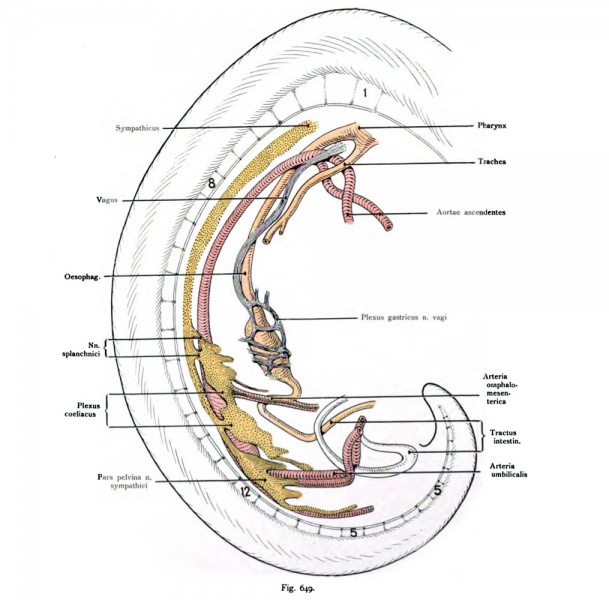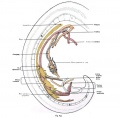File:Kollmann649.jpg

Original file (1,015 × 1,000 pixels, file size: 144 KB, MIME type: image/jpeg)
Fig. 649. Sympathetic and vagus of a human embryo of 10.2 mm
Nackensteifllänge.
(After His Younger)
Dorsal aorta runs from the sympathetic and the forms in the lower ex- section of the body already celiac ganglion and the facilities of the pelvic . ganglion Two short thick nerve, which in the trunk of the sympathetic penetrate the investments of the celiac ganglion, correspond to the nerves. splanchnic nerves. The Rami communicantes of the sympathetic nerve with the spinal nerve roots are not shown (see Fig 650). From the sympathetic Bauchganghen arise from short nerve trunks, which opposes the kidney and the mesentery are executed. The artery omphalomesenterica followed by a nerve branch the mesentery. The vagus is a powerful tribe of the stomach surrounds you with a wide braid.
- This text is a Google translate computer generated translation and may contain many errors.
Images from - Atlas of the Development of Man (Volume 2)
(Handatlas der entwicklungsgeschichte des menschen)
- Kollmann Atlas 2: Gastrointestinal | Respiratory | Urogenital | Cardiovascular | Neural | Integumentary | Smell | Vision | Hearing | Kollmann Atlas 1 | Kollmann Atlas 2 | Julius Kollmann
- Links: Julius Kollman | Atlas Vol.1 | Atlas Vol.2 | Embryology History
| Historic Disclaimer - information about historic embryology pages |
|---|
| Pages where the terms "Historic" (textbooks, papers, people, recommendations) appear on this site, and sections within pages where this disclaimer appears, indicate that the content and scientific understanding are specific to the time of publication. This means that while some scientific descriptions are still accurate, the terminology and interpretation of the developmental mechanisms reflect the understanding at the time of original publication and those of the preceding periods, these terms, interpretations and recommendations may not reflect our current scientific understanding. (More? Embryology History | Historic Embryology Papers) |
Reference
Kollmann JKE. Atlas of the Development of Man (Handatlas der entwicklungsgeschichte des menschen). (1907) Vol.1 and Vol. 2. Jena, Gustav Fischer. (1898).
Cite this page: Hill, M.A. (2024, April 28) Embryology Kollmann649.jpg. Retrieved from https://embryology.med.unsw.edu.au/embryology/index.php/File:Kollmann649.jpg
- © Dr Mark Hill 2024, UNSW Embryology ISBN: 978 0 7334 2609 4 - UNSW CRICOS Provider Code No. 00098G
Fig. 649. Sympathicas und Vagus, eines menschlichen Embryo von lO^Z mm
Nackensteifllänge.
(Nach His d. J.)
Dorsal von der Aorta zieht der Sympathicus und bildet im unteren Ab- schnitt des Körpers bereits die Anlagen des Ganglion coeliacum und der Becken- ganglien. Zwei kurze dicke Nerven, welche vom Stamm des Sympathicus in die Anlagen des Ganglion coeliacum eindringen, entsprechen den Nn. splanchnici. Die Rami communicantes des Sympathicus mit den Spinalnervenwurzeln sind nicht dargestellt (vergl. Fig. 650). Aus den Bauchganghen des Sympathicus entspringen kurze Nervenstämme, welche gegen die Niere und das Mesenterium hingerichtet sind. Auch der Arteria omphalo-mesenterica folgt ein Nervenast zum Mesenterium. Der Vagus bildet einen mächtigen Stamm, der den Magen mit einem breiten Geflecht umgibt.
File history
Click on a date/time to view the file as it appeared at that time.
| Date/Time | Thumbnail | Dimensions | User | Comment | |
|---|---|---|---|---|---|
| current | 09:47, 21 October 2011 |  | 1,015 × 1,000 (144 KB) | S8600021 (talk | contribs) | ==Fig. 649. Sympathetic and vagus of a human embryo of 10.2 mm== Nackensteifllänge. (After His Younger) Dorsal aorta runs from the sympathetic and the forms in the lower ex- section of the body already celiac ganglion and the facilities of the pelv |
You cannot overwrite this file.
File usage
The following page uses this file:
